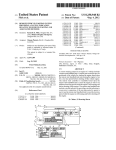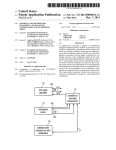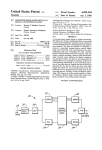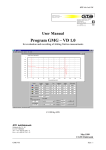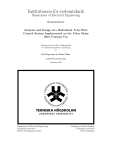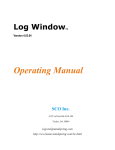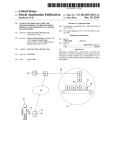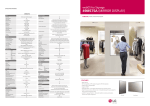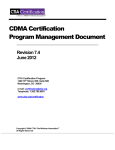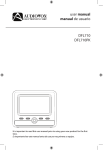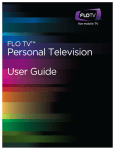Download Mobile terminal and controlling method thereof
Transcript
US008823654B2 (12) United States Patent (10) Patent N0.: (45) Date of Patent: Jeong et a1. (54) MOBILE TERMINAL AND CONTROLLING METHOD THEREOF (75) Inventors: Kye Sook Jeong, Seoul (KR); Jung Ok Cho, Seoul (KR); Seung Hyun Yang, Seoul (KR); Hee Young Cho, Seoul (KR) Notice: 2007/0101340 A1* 2008/0256477 2008/0261660 2009/0141024 2009/0244023 2010/0088598 Subject to any disclaimer, the term of this patent is extended or adjusted under 35 Yang ........................ .. 455/414.1 EP 2071145 6/2009 mons to Attend Oral Proceedings dated Mar. 19, 2013, 7 pages. Feb. 17, 2011 * cited by examiner Foreign Application Priority Data Aug. 11, 2009 4/2010 715/772 455/566 345/420 345/173 715/704 Apple Inc., “iPhone 3G User Manual,” Jul. 2008, XP-007907619. European Patent Of?ce Application Serial No. 100079425, Sum Prior Publication Data (30) Yoo ............................. .. 718/107 Apple Inc., “Apple Human Interface GuidelinesiUser Experience,” Sep. 2008, XP-007906962. May 4, 2010 US 2011/0037710A1 5/2007 OTHER PUBLICATIONS (21) Appl.No.: 12/773,791 (65) 6/2006 Fukuta 12/2006 Bystricky et al. 3/2007 Toyama et a1. FOREIGN PATENT DOCUMENTS U.S.C. 154(b) by 448 days. (22) Filed: Sep. 2, 2014 A1* 10/2008 Cho et al. A1* 10/2008 Huh et al. A1* 6/2009 Lee et al. A1* 10/2009 Kim et a1. A1* 4/2010 Lee et al. 2010/0105364 A1* (73) Assignee: LG Electronics Inc., Seoul (KR) (*) 2006/0120692 A1 2006/0288299 A1 2007/0047909 A1 US 8,823,654 B2 Primary Examiner * Quan-Zhen Wang (KR) ...................... .. 10-2009-0073783 Assistant Examiner * Tony Davis (74) Attorney, Agent, or Firm * Lee, Hong, Degerman, (51) Kang & Waimey Int. Cl. (2006.01) G06F 3/041 (57) (52) US. Cl. USPC (58) ........................................................ .. 345/173 Field of Classi?cation Search CPC G06F 3/04817; G11B 19/025; G11B 27/105; G11B 27/34; H04M1/72522; H04M1/72558; H04M 2250/22 USPC .......................... .. 715/863; 345/173; 718/107 See application ?le for complete search history. (56) References Cited U.S. PATENT DOCUMENTS 8,082,523 B2 * 2001/0040571 A1* 12/2011 11/2001 Forstall et al. .............. .. 715/863 Miller ......................... .. 345/419 2003/0112279 A1 6/2003 Irimajiri 2003/0119562 A1 6/2003 Kokubo ABSTRACT A mobile terminal and controlling method thereof are dis closed, Which facilitates a terminal to be used in further con sideration of user’s convenience. According to at least one of embodiments of the present invention, While a ?rst function is being executed in a mobile terminal, if a second function different from the ?rst function is executed, a ?rst function icon having execution progress status information of the ?rst function at a timing point of stopping the execution of the ?rst function can be generated. If the ?rst function is re-executed by selecting the ?rst function icon later, it is advantageous in that the ?rst function can be executed in a manner of being continuous With an execution progress status at the execution stop timing point. 13 Claims, 12 Drawing Sheets US. Patent Sep.2,2014 US 8,823,654 B2 Sheet10f12 xi “ 53:2 * W \m“ ... u. ... U S. Patent Sep.2,2014 Sheet20f12 §§ US 8,823,654 B2 US. Patent Sep.2,2014 Sheet30f12 3. w --------------\----------“\\ US 8,823,654 B2 U S. Patent Sep.2,2014 US 8,823,654 B2 Sheet40f12 1S:. . “ :\. \ U S. Patent Sep. 2, 2014 Sheet 5 0f 12 .....4....\\\>. US 8,823,654 B2 U S. Patent Sep. 2, 2014 Sheet 6 0f 12 US 8,823,654 B2 U S. Patent Sep. 2, 2014 Sheet 7 0f 12 .\ US 8,823,654 B2 \..“...“.““......‘...........um.mmw US. Patent Sep. 2, 2014 Sheet 8 0f 12 231-4 US 8,823,654 B2 U S Patent Sep.2,2014 Sheet90f12 US 8,823,654 B2 US. Patent Sep. 2, 2014 Sheet100f12 US 8,823,654 B2 U S. Patent Sep. 2, 2014 Sheet 11 0112 US 8,823,654 B2 U S Patent Sep. 2, 2014 Sheet120f12 US 8,823,654 B2 US 8,823,654 B2 1 2 MOBILE TERMINAL AND CONTROLLING METHOD THEREOF skill in the art upon examination of the following or may be learned from practice of the invention. The objectives and other advantages of the invention may be realized and attained by the structure particularly pointed out in the written description and claims hereof as well as the appended draw Pursuant to 35 U.S.C. §l 19(a), this application claims the bene?t of earlier ?ling date and right of priority to Korean Application No. 10-2009-0073783, ?led on Aug. 11, 2009, the contents of which are hereby incorporated by reference herein in their entirety. ings. To achieve these objects and other advantages and in accor dance with the purpose of the invention, as embodied and broadly described herein, a mobile terminal according to the BACKGROUND OF THE INVENTION present invention includes a touchscreen, and a controller is con?gured to, after a ?rst function has been executed such that a ?rst function window is being displayed on the touch screen, if a second function is newly executed, render the ?rst 1. Field of the Invention The present invention relates to a mobile terminal, and more particularly, to a mobile terminal and controlling function window to disappear by stopping the execution of method thereof. Although the present invention is suitable for a wide scope of applications, it is particularly suitable for facilitating a terminal to be used in further consideration of user’s convenience. 2. Discussion of the RelatedArt A mobile terminal is a device which may be con?gured to the ?rst function automatically, and display a ?rst function icon having execution progress status information of the ?rst function at an execution stop timing point of the ?rst function on the touchscreen. 20 perform various functions. Examples of such functions include data and voice communications, capturing images and video via a camera, recording audio, playing music ?les and outputting music via a speaker system, and displaying images and video on a display. Some terminals include addi tion includes displaying a ?rst function window on a touch screen when a ?rst function is executed, newly executing a second function in the course of executing the ?rst function, automatically stopping the execution of the ?rst function, 25 tional functionality which supports game playing, while other terminals are also con?gured as multimedia players. More rendering the ?rst function window to disappears, and dis playing a ?rst function icon having execution progress status information of the ?rst function at an execution stop timing point of the ?rst function on the touchscreen. It is to be understood that both the foregoing general recently, mobile terminals have been con?gured to receive broadcast and multicast signals which permit viewing of con tents, such as videos and television programs. Generally, terminals can be classi?ed into mobile termi nals and stationary terminals according to a presence or non In another aspect of the present invention, a method of controlling a mobile terminal according to the present inven 30 description and the following detailed description of the present invention are exemplary and explanatory and are intended to provide further explanation of the invention as claimed. presence of mobility. And, the mobile terminals canbe further classi?ed into handheld terminals and vehicle mount termi nals according to availability for hand-carry. There are ongoing efforts to support and increase the func tionality of mobile terminals. Such efforts include software and hardware improvements, as well as changes and improve ments in the structural components which form the mobile terminal. 35 The accompanying drawings, which are included to pro vide a further understanding of the invention and are incor porated in and constitute a part of this application, illustrate 40 Recently, mobile terminals capable of performing multi tasking functionality for executing at least two functions are ongoing to be released. However, when at least two functions are simultaneously executed in a mobile terminal, the multitasking occasionally fails to be smoothly executed due to the restricted perfor embodiment(s) of the invention and together with the descrip tion serve to explain the principle of the invention. In the drawings: 45 FIG. 1 is a block diagram of a mobile terminal according to one embodiment of the present invention; FIG. 2A is a front perspective diagram of a mobile terminal according to one embodiment of the present invention; FIG. 2B is a rear perspective diagram of a mobile terminal mance of the mobile terminal. Therefore, while one function is being executed in the mobile terminal, if another function is according to one embodiment of the present invention; executed, many efforts need to be further made to research and develop how to process the formerly executed function in consideration of terminal user’s convenience. BRIEF DESCRIPTION OF THE DRAWINGS FIG. 3 is a ?owchart for a method of controlling a mobile 50 terminal according to an embodiment of the present inven tion; and FIGS. 4 to 12 are diagrams for con?gurations of a display SUMMARY OF THE INVENTION Accordingly, the present invention is directed to a mobile screen on which a method of controlling a mobile terminal 55 according to an embodiment of the present invention is imple mented. terminal and controlling method thereof that substantially DETAILED DESCRIPTION OF THE INVENTION obviate one or more problems due to limitations and disad vantages of the related art. An object of the present invention is to provide a mobile terminal and controlling method thereof. While one function is being executed in the mobile terminal, if another function is Reference will now be made in detail to the preferred tion will be set forth in part in the description which follows embodiments of the present invention, examples of which are illustrated in the accompanying drawings. It is to be under stood by those of ordinary skill in this technological ?eld that other embodiments may be utilized, and structural, electrical, as well as procedural changes may be made without departing from the scope of the present invention. Wherever possible, the same reference numbers will be used throughout the and in part will become apparent to those having ordinary drawings to refer to the same or like parts. 60 executed, the present invention enables the formerly executed function to be properly processed in consideration of further enhancement of terminal user’s convenience. Additional advantages, objects, and features of the inven 65 US 8,823,654 B2 3 4 As used herein, the suf?xes ‘module’, ‘unit’ and ‘part’ are used for elements in order to facilitate the disclosure only. Therefore, signi?cant meanings or roles are not given to the suf?xes themselves and it is understood that the ‘module’, ‘unit’ and ‘part’ can be used together or interchangeably. tal multimedia broadcasting (DMB) and electronic service guide (ESG) of digital video broadcast-handheld (DVB-H). The broadcast receiving module 111 may be con?gured to receive broadcast signals transmitted from various types of broadcast systems. By nonlimiting example, such broadcast ing systems include digital multimedia broadcasting-terres trial (DMB-T), digital multimedia broadcasting-satellite (DMB-S), digital video broadcast-handheld (DVB-H), DVB CBMS, OMA-BCAST, the data broadcasting system known The present invention can be applicable to a various types of terminals. Examples of such terminals include mobile as well as stationary terminals, such as mobile phones, user equipment, smart phones, DTV, computers, digital broadcast terminals, personal digital assistants, portable multimedia players (PMP) and navigators. However, by way of non-limiting example only, further as media forward link only (MediaFLO®) and integrated services digital broadcast-terrestrial (ISDB-T). Optionally, the broadcast receiving module 111 can be con?gured suit able for other broadcasting systems as well as the above description will be with regard to a mobile terminal 100, and it should be noted that such teachings may apply equally to other types of terminals. explained digital broadcasting systems. The broadcast signal and/ or broadcast associated informa FIG. 1 is a block diagram of a mobile terminal 100 in accordance with an embodiment of the present invention. FIG. 1 shows the mobile terminal 100 according to one embodiment of the present invention includes a wireless com munication unit 110, an A/V (audio/video) input unit 120, a user input unit 130, a sensing unit 140, an output unit 150, a tion received by the broadcast receiving module 111 may be stored in a suitable device, such as a memory 160. 20 base station, external terminal, server, etc.). Such wireless signals may represent audio, video, and data according to text/multimedia message transceivings, among others. memory 160, an interface unit 170, a controller 180, a power supply unit 190 and the like. FIG. 1 shows the mobile terminal 100 having various components, but it is understood that implementing all of the illustrated components is not a requirement. Greater or fewer components may alternatively 25 be implemented. In the following description, the above elements of the 30 includes one or more components which permits wireless communication between the mobile terminal 100 and a wire less communication system or network within which the mobile terminal 100 is located. For instance, the wireless communication unit 110 can include a broadcast receiving module 111, a mobile communication module 112, a wireless internet module 113, a short-range communication module 114, a position-location module 115 and the like. The broadcast receiving module 111 receives a broadcast signal and/or broadcast associated information from an exter nal broadcast managing server via a broadcast channel. The broadcast channel may include a satellite channel and Interoperability for Microwave Access), HSDPA (High Speed Downlink Packet Access), etc. The short-range communication module 114 facilitates 35 relatively short-range communications. Suitable technolo gies for implementing this module include radio frequency identi?cation (RFID), infrared data association (IrDA), ultra wideband (UWB), as well at the networking technologies commonly referred to as Bluetooth and ZigBee, to name a 40 few. The position-location module 115 identi?es or otherwise obtains the location of the mobile terminal 1 00. If desired, this 45 module may be implemented with a global positioning sys tem (GPS) module. Referring to FIG. 1, the audio/video (A/V) input unit 120 is con?gured to provide audio or video signal input to the mobile terminal 100. As shown, the A/V input unit 120 a terrestrial channel. The broadcast managing server generally refers to a server which generates and transmits a broadcast signal and/or The wireless internet module 113 supports Internet access for the mobile terminal 100. This module may be internally or externally coupled to the mobile terminal 100. In this case, the wireless Internet technology can include WLAN (Wireless LAN) (Wi-Fi), Wibro (Wireless broadband), Wimax (World mobile terminal 100 are explained in sequence. First of all, the wireless communication unit 110 typically The mobile communication module 112 transmits/receives wireless signals to/from one or more network entities (e.g., broadcast associated information or a server which is pro includes a camera 121 and a microphone 122. The camera 121 vided with a previously generated broadcast signal and/or receives and processes image frames of still pictures or video, broadcast associated information and then transmits the pro vided signal or information to a terminal. The broadcast sig nal may be implemented as a TV broadcast signal, a radio broadcast signal, and a data broadcast signal, among others. If desired, the broadcast signal may further include a broadcast signal combined with a TV or radio broadcast signal. At least two broadcast receiving modules 111 can be pro vided to the mobile terminal 100 in pursuit of simultaneous receptions of at least two broadcast channels or broadcast which are obtained by an image sensor in a video call mode or 50 stored in the memory 160 or can be externally transmitted via the wireless communication unit 110. Optionally, at least two cameras 121 can be provided to the mobile terminal 100 55 channel switching facilitation. audio signal is processed and converted into electric audio 60 tion may include an electronic program guide (EPG) of digi data. The processed audio data is transformed into a format transmittable to a mobile communication base station via the mobile communication module 112 in case of a call mode. associated information can be provided via a mobile commu nication network. In this case, the broadcast associated infor mation can be received by the mobile communication module 112. The broadcast associated information can be implemented in various forms. For instance, broadcast associated informa according to environment of usage. The microphone 122 receives an external audio signal while the portable device is in a particular mode, such as phone call mode, recording mode and voice recognition. This The broadcast associated information includes informa tion associated with a broadcast channel, a broadcast pro gram, a broadcast service provider, etc. And, the broadcast a photographing mode. And, the processed image frames can be displayed on the display 151. The image frames processed by the camera 121 can be The microphone 122 typically includes assorted noise remov ing algorithms to remove noise generated in the course of 65 receiving the external audio signal. The user input unit 130 generates input data responsive to user manipulation of an associated input device or devices. US 8,823,654 B2 5 6 Examples of such devices include a keypad, a dome switch, a output device. In this case, the touch sensor can be con?gured as a touch ?lm, a touch sheet, a touchpad or the like. touchpad (e. g., static pressure/ capacitance), a jog wheel, a jog The touch sensor can be con?gured to convert a pressure switch, etc. applied to a speci?c portion of the display 151 or a variation The sensing unit 140 provides sensing signals for control of a capacitance generated from a speci?c portion of the display 151 to an electric input signal. Moreover, it is able to ling operations of the mobile terminal 100 using status mea surements of various aspects of the mobile terminal. For instance, the sensing unit 140 may detect an open/ close status of the mobile terminal 100, relative positioning of compo nents (e.g., a display and keypad) of the mobile terminal 100, con?gure the touch sensor to detect a pressure of a touch as well as a touched position or size. If a touch input is made to the touch sensor, signal(s) corresponding to the touch is transferred to a touch controller. a change of position of the mobile terminal 100 or a compo nent of the mobile terminal 100, a presence or absence of user The touch controller processes the signal(s) and then transfers the processed signal(s) to the controller 180. Therefore, the contact with the mobile terminal 100, orientation or accelera tion/ deceleration of the mobile terminal 100. As an example, consider the mobile terminal 100 being con?gured as a slide controller 180 is able to know whether a prescribed portion of the display 151 is touched. Referring to FIG. 1, a proximity sensor (not shown in the type mobile terminal. In this con?guration, the sensing unit drawing) can be provided to an internal area of the mobile terminal 100 enclosed by the touchscreen or around the 140 may sense whether a sliding portion of the mobile termi nal is open or closed. Other examples include the sensing unit touchscreen. The proximity sensor is the sensor that detects a presence or non-presence of an object approaching a pre 140 sensing the presence or absence of power provided by the power supply 190, the presence or absence of a coupling or other connection between the interface unit 170 and an exter nal device. And, the sensing unit 140 can include a proximity 20 scribed detecting surface or an object existing around the proximity sensor using an electromagnetic ?eld strength or infrared ray without mechanical contact. Hence, the proxim ity sensor has durability longer than that of a contact type sensor and also has utility wider than that of the contact type 25 sensor. sensor 141. The output unit 150 generates outputs relevant to the senses of sight, hearing, touch and the like. And, the output unit 150 includes the display 151, an audio output module 152, an alarm unit 153, a haptic module 154, a projector module 155 and the like. The display 151 is typically implemented to visually dis play (output) information associated with the mobile terminal The proximity sensor can include one of a transmittive photoelectric sensor, a direct re?ective photoelectric sensor, a 30 mirror re?ective photoelectric sensor, a radio frequency oscil lation proximity sensor, an electrostatic capacity proximity sensor, a magnetic proximity sensor, an infrared proximity 100. For instance, if the mobile terminal is operating in a sensor and the like. In case that the touchscreen includes the phone call mode, the display will generally provide a user electrostatic capacity proximity sensor, it is con?gured to interface (UI) or graphical user interface (GUI) which detect the proximity of a pointer using a variation of electric ?eld according to the proximity of the pointer. In this case, the touchscreen (touch sensor) can be classi?ed as the proximity includes information associated with placing, conducting, and terminating a phone call. As another example, if the 35 mobile terminal 100 is in a video call mode or a photograph sensor. ing mode, the display 151 may additionally or alternatively In the following description, for clarity, an action that a display images which are associated with these modes, the UI pointer approaches without contacting with the touchscreen to be recognized as located on the touchscreen is named or the GUI. The display module 151 may be implemented using known 40 display technologies including, for example, a liquid crystal display (LCD), a thin ?lm transistor-liquid crystal display (TFT-LCD), an organic light-emitting diode display (OLED), ing of the position on the touchscreen proximity-touched by the pointer means the position of the pointer which vertically opposes the touchscreen when the pointer performs the prox a ?exible display and a three-dimensional display. The mobile terminal 100 may include one or more of such dis 45 imity touch. 50 imity touch pattern (e.g., a proximity touch distance, a prox imity touch duration, a proximity touch position, a proximity touch shift state, etc.). And, information corresponding to the detected proximity touch action and the detected proximity plays. The proximity sensor detects a proximity touch and a prox Some of the above displays can be implemented in a trans parent or optical transmittive type, which can be named a transparent display. As a representative example for the trans parent display, there is TOLED (transparent OLED) or the like. A rear con?guration of the display 151 can be imple mented in the optical transmittive type as well. In this con ?guration, a user is able to see an object in rear of a terminal body via the area occupied by the display 151 of the terminal body. 55 At least two displays 151 can be provided to the mobile terminal 100 in accordance with the implemented con?gura tion of the mobile terminal 100. For instance, a plurality of displays can be arranged on a single face of the mobile ter minal 100 in a manner of being spaced apart from each other or being built in one body. Alternatively, a plurality of dis plays can be arranged on different faces of the mobile termi nal 100. able to use the display 151 as an input device as well as an touch pattern can be outputted to the touchscreen. The audio output module 152 functions in various modes including a call-receiving mode, a call-placing mode, a recording mode, a voice recognition mode, a broadcast recep tion mode and the like to output audio data which is received from the wireless communication unit 110 or is stored in the memory 160. During operation, the audio output module 152 outputs audio relating to a particular function (e.g., call received, message received, etc.). The audio output module 60 152 is often implemented using one or more speakers, buZZ ers, other audio producing devices, and combinations thereof. The alarm unit 153 is output a signal for announcing the In case that the display 151 and a sensor for detecting a touch action (hereinafter called ‘touch sensor’) con?gures a mutual layer structure (hereinafter called ‘touchscreen’), it is ‘proximity touch’. And, an action that a pointer actually touches the touchscreen is named ‘contact touch’. The mean 65 occurrence of a particular event associated with the mobile terminal 100. Typical events include a call received event, a message received event and a touch input received event. The alarm unit 153 is able to output a signal for announcing the event occurrence by way of vibration as well as video or audio US 8,823,654 B2 7 8 signal. The video or audio signal can be outputted via the display 151 or the audio output unit 152. Hence, the display Moreover, data for various patterns of vibration and/or sound outputted in case of a touch input to the touchscreen can be stored in the memory unit 160. 151 or the audio output module 152 can be regarded as a part of the alarm unit 153. In the memory 160, data about touch gestures, which The haptic module 154 generates various tactile effects that respectively correspond to prescribed execution functions, can be sensed by a user. Vibration is a representative one of the can be further stored. Therefore, if one touch gesture is per formed on the touchscreen, one of the prescribed functions corresponding to the touch gesture can be executed in the mobile terminal 100. The memory 160 may be implemented using any type or combination of suitable volatile and non-volatile memory or tactile effects generated by the haptic module 154. Strength and pattern of the vibration generated by the haptic module 154 are controllable. For instance, different vibrations can be outputted in a manner of being synthesized together or can be outputted in sequence. The haptic module 154 is able to generate various tactile effects as well as the vibration. For instance, the haptic mod ule 154 generates the effect attributed to the arrangement of storage devices including hard disk, random access memory (RAM), static random access memory (SRAM), electrically erasable pro grammable read-only memory (EEPROM), eras pins vertically moving against a contact skin surface, the able programmable read-only memory (EPROM), program mable read-only memory (PROM), read-only memory (ROM), magnetic memory, ?ash memory, magnetic or opti effect attributed to the injection/ suction power of air though an injection/ suction hole, the effect attributed to the skim over a skin surface, the effect attributed to the contact with elec cal disk, multimedia card micro type memory, card-type trode, the effect attributed to the electrostatic force, the effect attributed to the representation of hold/cold sense using an endothermic or exothermic device and the like. The haptic module 154 can be implemented to enable a 20 user to sense the tactile effect through a muscle sense of ?nger, arm or the like as well as to transfer the tactile effect through a direct contact. Optionally, at least two haptic mod 25 ules 154 can be provided to the mobile terminal 100 in accor dance with the corresponding con?guration type of the the power and then transfers the data or power to the respec tive elements of the mobile terminal 100 or enables data within the mobile terminal 100 to be transferred to the exter mobile terminal 100. The projector module 155 is the element for performing an image projector function using the mobile terminal 100. And, 30 the projector module 155 is able to display an image, which is identical to or partially different at least from the image displayed on the display 151, on an external screen or wall according to a control signal of the controller 180. In particular, the projector module 155 can include a light 35 source (not shown in the drawing) generating light (e.g., laser) for projecting an image extemally, an image producing means (not shown in the drawing) for producing an image to output externally using the light generated from the light source, and a lens (not shown in the drawing) for enlarging to 40 output the image externally in a predetermined focus dis nal devices. The interface unit 170 may be con?gured using a wired/wireless headset port, an external charger port, a wired/ wireless data port, a memory card port, a port for coupling to a device having an identity module, audio input/ output ports, video input/ output ports, an earphone port and/ or the like. The identity module is the chip for storing various kinds of information for authenticating a use authority of the mobile terminal 100 and can include User Identify Module (UIM), Subscriber Identify Module (SIM), Universal Subscriber Identity Module (U SIM) and/ or the like. A device having the identity module (hereinafter called ‘identity device’) can be manufactured as a smart card. Therefore, the identity device is connectible to the mobile terminal 100 via the correspond tance. And, the projector module 155 can further include a ing port. device (not shown in the drawing) for adjusting an image projected direction by mechanically moving the lens or the whole module. The projector module 155 can be classi?ed into a CRT memory (e.g., SD memory, XD memory, etc.), or other simi lar memory or data storage device. And, the mobile terminal 100 is able to operate in association with a web storage for performing a storage function of the memory 160 on Internet. The interface unit 170 is often implemented to couple the mobile terminal 100 with external devices. The interface unit 170 receives data from the external devices or is supplied with When the mobile terminal 110 is connected to an external 45 cradle, the interface unit 170 becomes a passage for supplying the mobile terminal 100 with a power from the cradle or a passage for delivering various command signals inputted (cathode ray tube) module, an LCD (liquid crystal display) module, a DLP (digital light processing) module or the like from the cradle by a user to the mobile terminal 100. Each of according to a device type of a display means. In particular, the various command signals inputted from the cradle or the the DLP module is operated by the mechanism of enabling the 50 power can operate as a signal enabling the mobile terminal 55 100 to recognize that it is correctly loaded in the cradle. The controller 180 typically controls the overall operations of the mobile terminal 100. For example, the controller 180 performs the control and processing associated with voice calls, data communications, video calls, etc. The controller light generated from the light source to re?ect on a DMD (digital micro-mirror device) chip and can be advantageous for the downsiZing of the projector module 151. Preferably, the projector module 155 can be provided in a length direction of a lateral, front or backside direction of the mobile terminal 100. And, it is understood that the projector module 155 can be provided to any portion of the mobile terminal 100 according to the necessity thereof. 180 may include a multimedia module 181 that provides multimedia playback. The multimedia module 181 may be con?gured as part of the controller 180, or implemented as a separate component. The memory unit 160 is generally used to store various types of data to support the processing, control, and storage requirements of the mobile terminal 100. Examples of such data include program instructions for applications operating on the mobile terminal 100, contact data, phonebook data, messages, audio, still pictures, moving pictures, etc. And, a 60 Moreover, the controller 180 is able to perform a pattern recogniZing process for recogniZing a writing input and a picture drawing input carried out on the touchscreen as char acters or images, respectively. recent use history or a cumulative use frequency of each data 65 various components for the mobile terminal 100. The power (e.g., use frequency for each phonebook, each message or each multimedia) can be stored in the memory unit 160. The power supply unit 190 provides power required by the may be internal power, external power, or combinations thereof. US 8,823,654 B2 10 Various embodiments described herein may be imple mented in a computer-readable medium using, for example, computer software, hardware, or some combination thereof. For a hardware implementation, the embodiments described for a switching to a touch recognizing mode of the display 151 or the like can be inputted to the second manipulating unit 132. FIG. 2B is a perspective diagram of a backside of the terminal shown in FIG. 2A. Referring to FIG. 2B, a camera 121' can be additionally provided to a backside of the terminal body, and more par herein may be implemented within one or more application speci?c integrated circuits (ASICs), digital signal processors (DSPs), digital signal processing devices (DSPDs), program mable logic devices (PLDs), ?eld programmable gate arrays (FPGAs), processors, controllers, micro-controllers, micro ticularly, to the rear case 102. The camera 121 has a photo processors, other electronic units designed to perform the former camera 121 shown in FIG. 21A and may have pixels differing from those of the ?rmer camera 121. Preferably, for instance, the former camera 121 has low graphing direction that is substantially opposite to that of the functions described herein, or a selective combination thereof. Such embodiments may also be implemented by the controller 180. For a software pixels enough to capture and transmit a picture of user’s face for a video call, while the latter camera 121' has high pixels for capturing a general subject for photography without trans mitting the captured subject. And, each of the cameras 121 implementation, the embodiments described herein may be implemented with separate software modules, such as procedures and functions, each of which and 121' can be installed at the terminal body to be rotated or perform one or more of the functions and operations described herein. The software codes can be implemented with a software application written in any suitable program ming language and may be stored in memory such as the memory 160, and executed by a controller or processor, such popped up. A ?ash 123 and a mirror 124 are additionally provided 20 as the controller 180. FIG. 2A is a front perspective diagram of a mobile terminal according to one embodiment of the present invention. The mobile terminal 100 shown in the drawing has a bar the camera 121'. In case that a user attempts to take a picture of the user (self-photography) using the camera 121', the 25 type terminal body. Yet, the mobile terminal 100 may be implemented in a variety of different con?gurations. 30 type mobile terminal 100. However such teachings apply equally to other types of mobile terminals. Referring to FIG. 2A, the mobile terminal 100 includes a case (casing, housing, cover, etc.) con?guring an exterior thereof. In the present embodiment, the case can be divided mirror 124 enables the user to view user’ s face re?ected by the mirror 124. An additional audio output unit 152' can be provided to the backside of the terminal body. The additional audio output Examples of such con?gurations include folder-type, slide type, rotational-type, swing-type and combinations thereof. For clarity, further disclosure will primarily relate to a bar adjacent to the camera 121'. The ?ash 123 projects light toward a subject in case of photographing the subject using unit 152' is able to implement a stereo function together with the former audio output unit 152 shown in FIG. 2A and may be used for implementation of a speakerphone mode in talk ing over the terminal. A broadcast signal receiving antenna 124 can be addition ally provided to the lateral side of the terminal body as well as an antenna for communication or the like. The antenna 124 35 constructing a portion of the broadcast receiving module 111 into a front case 101 and a rear case 102. Various electric/ shown in FIG. 1 can be retractably provided to the terminal electronic parts are loaded in a space provided between the body. front and rear cases 101 and 102. Optionally, at least one A power supply unit 190 for supplying a power to the middle case can be further provided between the front and terminal 100 is provided to the terminal body. And, the power supply unit 190 can be con?gured to be built within the terminal body. Alternatively, the power supply unit 190 can be con?gured to be detachably connected to the terminal body. A touchpad 135 for detecting a touch can be additionally rear cases 101 and 102 in addition. 40 The cases 101 and 102 are formed by injection molding of synthetic resin or can be formed of metal substance such as stainless steel (STS), titanium (Ti) or the like for example. provided to the rear case 102. The touchpad 135 can be A display 151, an audio output unit 152, a camera 121, user input units 130/131 and 132, a microphone 122, an interface 180 and the like can be provided to the terminal body, and 45 more particularly, to the front case 101. The display 151 occupies most of a main face of the front case 101. The audio output unit 151 and the camera 121 are provided to an area adjacent to one of both end portions of the 50 con?gured in a light transmittive type like the display 151. In this case, if the display 151 is con?gured to output visual information from its both faces, it is able to recognize the visual information via the touchpad 135 as well. The infor mation outputted from both of the faces can be entirely con trolled by the touchpad 135. Alternatively, a display is further display 151, while the user input unit 131 and the microphone provided to the touchpad 135 so that a touchscreen can be 122 are provided to another area adjacent to the other end provided to the rear case 102 as well. portion of the display 151. The user input unit 132 and the The touchpad 135 is activated by interconnecting with the interface 170 can be provided to lateral sides of the front and display 151 of the front case 101. The touchpad 135 can be rear cases 101 and 102. 55 The input unit 130 is manipulated to receive a command for 135 can have a size equal to or smaller than that of the display 151. controlling an operation of the terminal 100. And, the input unit 130 is able to include a plurality of manipulating units 131 and 132. The manipulating units 131 and 132 can be named a manipulating portion and may adopt any mechanism provided in rear of the display 151 in parallel. The touchpad In the following description, embodiments related to a controlling method, which can be implemented in the mobile 60 terminal 100, are explained with reference to the accompa of a tactile manner that enables a user to perform a manipu nying drawings. lation action by experiencing a tactile feeling. Content inputted by the ?rst or second manipulating unit If the display module 151 includes a touchscreen, imple mentation of the following embodiment is further facilitated. Therefore, the following description is made on the assump tion that the display module 151 includes a touchscreen. And, 131 or 132 can be diversely set. For instance, such a command as start, end, scroll and the like is inputted to the ?rst manipu lating unit 131. And, a command for a volume adjustment of sound outputted from the audio output unit 152, a command 65 a display screen of the touchscreen 151 is indicated by a reference number 400 in the following description. US 8,823,654 B2 11 12 FIG. 3 is a ?owchart for a method of controlling a mobile Execution progress status information of the video play terminal according to an embodiment of the present inven tion, and FIGS. 4 to 12 are diagrams for con?gurations of a function at a timing point of newly executing the e-book menu, i.e., at the timing point of stopping the execution of the display screen on which a method of controlling a mobile video play function can be stored in the memory 160. A video play function icon 413 linked to the execution progress status information is generated and then displayed on the touch terminal according to an embodiment of the present invention is implemented. Referring to (4-1) of FIG. 4, the mobile terminal 100 is executing an audio play function for playing such audio as music while an audio play window 421 is being displayed on screen 400. The execution progress status information of the video play function icon 413 is similar to that of the audio play function icon 411. the touchscreen 400 [S31]. An audio menu icon 401, a video The execution progress status information of the video play menu icon 403 and an e-book menu icon 405 are exemplarily function icon 413 can include a video ?le name, which was displayed on the touchscreen 400. According to the present embodiment, it is not mandatory for the menu icons 401, 403 and 405 to be displayed. Optionally, another menu icon is being played at the timing point of stopping the execution of the video play function, the corresponding play stop time and the like. Therefore, by referring to the execution progress status information, if the video play function is re-executed later, it is able to play back the video ?le continuous with the play stop time. This shall be explained later. Referring to (4-5) of FIG. 4, an e-book viewer window 423 added to the menu icons 401, 403 and 405 with or without replacing at least one of the menu icons 401, 403 and 405. It is able to con?gure the audio play function to be executed by touching the audio menu icon 401. Alternatively, it is able to execute the audio play function through a proper manipu lation of the user input unit 130 instead of touching the audio 20 In the following description, the audio play function icon menu icon 401. In this alternative case, the audio menu icon 401 may not be displayed on the touchscreen 400. This mechanism is applicable to other menu icons. Subsequently, in order to execute another menu (e.g., a video menu) in the course of executing the audio play func tion, the video menu icon 403 is touched for example [S32]. If so, referring to (4-2) of FIG. 4, the audio play function is stopped in the mobile terminal 100 [S33]. The audio play function window 421 disappears from the touchscreen 400 [S34]. Execution progress status information of the audio play function at a timing point of newly executing the video menu, i.e., at the timing point of stopping the execution of the audio play function can be stored in the memory 160. An audio play 411 is explained in detail with reference to FIG. 5. Referring to (5-1) of FIG. 5, the audio play function icon 25 411 and the video play function icon 413 are displayed on the touchscreen 400. The audio play function icon 411 is selected by being touched. If so, referring to (5-2) ofFIG. 5, the controller 180 plays a 30 corresponding audio ?le (i.e., an audio ?le stopped in the course of playback) continuous from a corresponding play stop time (e.g., 1 minute 53 seconds) by referring to the execution progress status information corresponding to the 35 function icon 411 linked to the execution progress status information is generated and then displayed on the touch screen 400 [S35]. In this following description, ‘linking the audio play function icon 411 to the execution progress status information’ may be represented in a manner that the audio is displayed on the touchscreen 400 and an e-book viewer function is executed. audio play function icon 411. In the above description, the audio play function icon 411 and the video play function icon 413 are described. Regarding the audio play function, at least two audio icons can be gen erated as well as one audio play function icon. This is explained in detail with reference to FIG. 6 as follows. 40 Referring to (6-1) of FIG. 6, the audio menu icon 401, the play function icon 411 is provided with the execution video menu icon 403 and the e-book menu icon 405 are progress status information. In this case, the execution progress status information can include an audio ?le name, which was being played at the exemplarily displayed on the touchscreen 400. The audio play function icon 411 and the video play function icon 413 timing point of stopping the execution of the audio play function, the corresponding play stop time (e. g., 1 minute 53 seconds) and the like. Therefore, by referring to the execution are displayed on the touchscreen 400. The processes for gen 45 progress status information, if the audio play function is re-executed later, it is able to play back the audio ?le continu ous with the execution progress status at the execution 50 stopped timing point. In particular, it is able to play back the shall be named a ?rst audio play function icon 411. The audio ?le related to the ?rst audio play function icon 411 shall be audio ?le, which was paused in the course of playback, con tinuously from the play stop time. This shall be explained later. Referring to (4-3) of FIG. 4, a video play window 423 is displayed on the touchscreen 400 and the video play function is executed. named a ?rst audio ?le to be discriminated from other audio 55 Subsequently, if the audio menu icon 401 is touched and Optionally, the disappearance of the audio play window, 60 video play window are performed in random order or can be performed at the same time substantially. Referring to (4-3) of FIG. 4, the e-book menu icon 405 is is executed in the mobile terminal 100 and the audio play window 421 is displayed on the touchscreen 400. A second audio ?le different from the ?rst audio ?le is selected via the audio play window 421 and can be then executed. This is apparent to those skilled in the art without separate descrip tion. And, the corresponding details shall be omitted from the selected by being touched. If so, referring to (4-4) of FIG. 4, the video play function is stopped in the mobile terminal 100. The video play function window 423 then disappears from the touchscreen 400. ?les explained in the following description. selected, referring to (6-2) of FIG. 6, the audio play function the generation of the audio play function icon and the execu tion of the video play function according to the displayed erating the audio and video play function icons 411 and 413 are explained in the foregoing description, of which details are omitted from the following description for clarity of this disclosure. In order to discriminate the audio play function icon 411 from another audio play function icon 415 newly generated in the following description, the audio play function icon 411 65 following description for clarity of this disclosure. Subsequently, while the audio play function is being executed, the video menu icon 403 is touched to execute another menu (e.g., a video menu) for example. US 8,823,654 B2 13 14 If so, referring to (6-3) of FIG. 6, the audio play function is stopped in the mobile terminal 100. The audio play function window 421 then disappears from the touchscreen 400. Subsequently, a second audio play function icon 415 is displayed on the touchscreen 400. The second audio play function icon 415 is easily understandable from the descrip tion of the aforesaid ?rst audio play function icon 411, of which details are omitted from the following description for clarity of this disclosure. Referring to (6-4) of FIG. 6, a video play window 423 is displayed on the touchscreen 400 and the video play function each other. The touch gesture of the different type is non limited by the present invention. When the play function icons 411, 413 and 415 are arranged adjacent to each other, it is not mandatory for the play function icons 411, 413 and 415 to be arranged in one row shown in FIG. 7. Optionally, the play function icons 411, 413 and 415 can be arranged in various styles. This is explained in detail with reference to FIG. 8 as follows. Referring to FIG. 8, the play function icons 411, 413 and 415 can be arranged adjacent to each other into a bundle of a spring note type. is then executed. Each time a touch & drag is performed on the bundle n one In the following description, arrangements of the play direction, the play function icons 411, 413 and 415, as shown function icons on the touchscreen 400 are explained with reference to FIG. 7 and FIG. 8. in (8-2) of FIG. 8, can be turned over one by one in a direction of the touch & drag. And, the following con?guration is possible. First of all, if Referring to (7-1) of FIG. 7, the ?rst audio play function icon 411, the video play function icon 413 and the second audio play function icon 415 are exemplarily displayed on the touchscreen 400 in a manner of being spaced apart from each other by a predetermined distance. A touch gesture of a prescribed type is performed on the touchscreen 400. For example, the touch gesture of the pre scribed type, as shown in (7-1) of FIG. 7, can be performed in 20 a manner of touching two points of the touchscreen 400 with 25 a touch is performed on the bundle, the play function icon two ?ngers simultaneously and then dragging the ?ngers to get closer to each other. If so, referring to (7-2) of FIG. 7, the three play function icons 411, 413 and 415 can be relocated in a manner ofbeing adj acently positioned into one bundle. 30 When the three play function icons 411, 413 and 415 are relocated in a manner of being adj acently positioned into one bundle, play function icons in the same category, as shown in (7-3) of FIG. 3, can be arranged in a manner of being grouped to be discriminated from other categories. Referring to (7-3) ofFIG. 7, when the three play function icons 411,413 and 415 35 are relocated in a manner of being adjacently positioned into one bundle, the ?rst and second audio play function icons 411 and 415 pertaining to the audio category are sorted together to be arranged by a sub -bundle within the corresponding bundle. Therefore, the ?rst and second audio play function icons 411 FIG. 8) unfolded in a most front right side of the bundle is selected. A corresponding function is then executed. The following description is made with reference to FIG. 9. Referring to (9-1) of FIG. 9, a virtual polyhedron 500 can be displayed on the touchscreen 400. No limitation is put on the polyhedron 500. For instance, the polyhedron can include a square pillar or a trigonal prism. In (8-1) of FIG. 8, exem plarily shown is that one facet of the polyhedron, i.e., a ?rst facet 510 is displayed in front direction on the touchscreen 400. The e-book menu icon 405 and the e-book play function icon 417 are exemplarily displayed on the ?rst facet 510. A user command for rotating the polyhedron 500 can be inputted via the user input unit 130. In this case, the user command can include a touch & drag in one direction on the touchscreen 400 for example. If so, referring to (9-2) and (9-3) of FIG. 9, the polyhedron 500 is rotated. Accordingly, as the polyhedron 500 is rotated, another facet of the polyhedron 500, i.e., a second facet 520, 40 as shown in (9-3) of FIG. 9, can be displayed. The audio menu icon 401, the video menu icon 403 and the audio play function icon 411 and the video play function icon 413 are exemplarily displayed on the second facet 520. 45 function icons adjacent to each other can be performed on the touchscreen 400. and 415 are sorted to form the sub-bundle within the corre sponding bundle and the play function icon (i.e., the video play function icon 413) pertaining to a different category is arranged adjacent to the sub-bundle. It is not mandatory for the three play function icons 411, (e.g., the ?rst audio play function icon 411 shown in (8-1) of FIG. 8, the video play function icon 413 shown in (8-2) of A touch gesture of a prescribed type for arranging the play 413 and 415 to be arranged adjacent to each other as one If so, referring to (9-4) of FIG. 9, the audio play function bundle. Referring to (7-4) of FIG. 7, the play function icons icon 411 and the video play function icon 413 on the second facet 510 and the e-book play function icon 417 provided to the ?rst facet 510 can be adjacently arranged on the second facet 520. pertaining to one category among the three play function icons 411, 413 and 415 can be arranged into a different bundle. Even if the touch gesture of the prescribed type is not performed, if a prescribed number of play function icons are generated on the touchscreen 400, they can be con?gured in a manner of being automatically arranged adjacent to each 50 55 other. shifted to the second facet 520. If play function icons exist on other facets except the ?rst Meanwhile, when the play function icons are arranged adjacent to each other on the touchscreen 4000, if a touch gesture of a type different from that of the former gesture is performed, the play function icons are restored into the origi nal formation, as shown in (7-1) of FIG. 7, to be arranged in a manner of being spaced from each other. The latter touch and second facets of the polyhedron 500, they can be included in the bundle by being shifted to the second facet 510. 60 corresponding bundle. Alternatively, the latter touch gesture two points of the touchscreen 400 with two ?ngers simulta neously and then dragging the two ?ngers to get farther from FIG. 10 and FIG. 11 are described as follows. Referring to (10-1) of FIG. 10, the second facet 520 of the polyhedron 500 is displayed on the touchscreen 400. The mobile terminal 100 is executing the audio play function and gesture of the different type can include a double click on the of the different type can be performed in a manner of touching Therefore, referring to (9-5) and (9-6) of FIG. 9, even if the polyhedron 500 is rotated again to display ?rst facet 510 on the touchscreen 400, the e-book play function icon 417 used to be on the ?rst facet 510 may not be displayed by being 65 the audio play function window 421 is displayed on the sec ond facet 520 of the polyhedron 500. On the second facet 520, the audio menu icon 401 and the video menu icon 403 are exemplarily displayed.






















